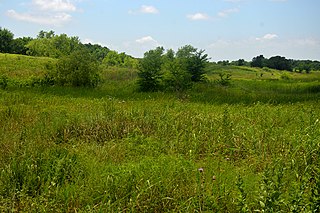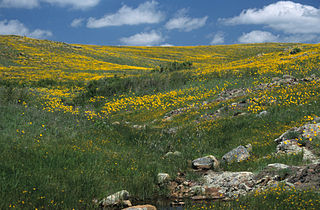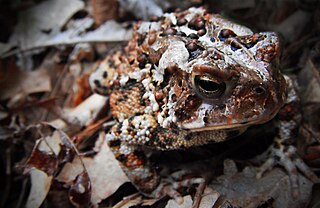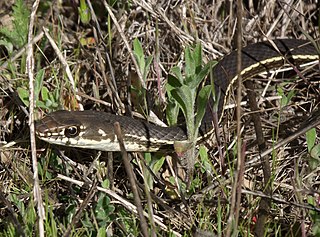
The upland sandpiper is a large sandpiper, closely related to the curlews. Older names are the upland plover and Bartram's sandpiper. In Louisiana, it is also colloquially known as the papabotte. It is the only member of the genus Bartramia. The genus name and the old common name Bartram's sandpiper commemorate the American naturalist William Bartram. The species name longicauda is from Latin longus, "long" and caudus, "tail". The name "Bartram's sandpiper" was made popular by Alexander Wilson, who was taught ornithology and natural history illustration by Bartram.

LeConte's sparrow is one of the smallest New World sparrow species in North America.

The Piney Woods is a temperate coniferous forest terrestrial ecoregion in the Southern United States covering 54,400 square miles (141,000 km2) of East Texas, southern Arkansas, western Louisiana, and southeastern Oklahoma. These coniferous forests are dominated by several species of pine as well as hardwoods including hickory and oak. Historically the most dense part of this forest region was the Big Thicket though the lumber industry dramatically reduced the forest concentration in this area and throughout the Piney Woods during the 19th and 20th centuries. The World Wide Fund for Nature considers the Piney Woods to be one of the critically endangered ecoregions of the United States. The United States Environmental Protection Agency (EPA) defines most of this ecoregion as the South Central Plains.

The eastern newt is a common newt of eastern North America. It frequents small lakes, ponds, and streams or nearby wet forests. The eastern newt produces tetrodotoxin, which makes the species unpalatable to predatory fish and crayfish. It has a lifespan of 12 to 15 years in the wild, and it may grow to 5 in (13 cm) in length. These animals are common aquarium pets, being either collected from the wild or sold commercially. The striking bright orange juvenile stage, which is land-dwelling, is known as a red eft. Some sources blend the general name of the species and that of the red-spotted newt subspecies into the eastern red-spotted newt.

The massasauga is a rattlesnake species found in midwestern North America from southern Ontario to northern Mexico and parts of the United States in between. Three subspecies are currently recognized including the nominate subspecies described here. Like all rattlesnakes, it is a pit viper, and like all pit vipers, it is venomous.

The Texas Blackland Prairies are a temperate grassland ecoregion located in Texas that runs roughly 300 miles (480 km) from the Red River in North Texas to San Antonio in the south. The prairie was named after its rich, dark soil. Less than 1% of the original Blackland prairie vegetation remains, scattered across Texas in parcels.

Wichita Mountains Wildlife Refuge, located in southwestern Oklahoma near Lawton, has protected unique wildlife habitats since 1901 and is the oldest managed wildlife facility in the United States Fish and Wildlife Service system. The refuge's location in the geologically unique Wichita Mountains and its areas of undisturbed mixed grass prairie make it an important conservation area. The Wichitas are approximately 500 million years old. Measuring about 59,020 acres (238.8 km2), the refuge hosts a great diversity of species: 806 plant species, 240 species of birds, 36 fish, and 64 reptiles and amphibians are present.

Crotalus viridis is a venomous pit viper species native to the western United States, southwestern Canada, and northern Mexico. Currently, two subspecies are recognized, including the prairie rattlesnake, the nominate subspecies, and the Hopi rattlesnake.

Fowler's toad is a species of toad in the family Bufonidae. The species is native to North America, where it occurs in much of the eastern United States and parts of adjacent Canada. It was previously considered a subspecies of Woodhouse's toad.

Sprague's pipit(Anthus spragueii) is a small songbird (passerine) in the family Motacillidae that breeds in the short- and mixed-grass prairies of North America. Migratory, it spends the winters in the southwestern United States and northern Mexico. Sprague's pipits are unusual among songbirds in that they sing high in the sky, somewhat like a goldfinch or skylark. It is more often identified by its distinctive descending song heard from above than by being seen on the ground. Males and females are cryptically coloured and similar in appearance; they are a buffy brown with darker streaking, slender bills and pinkish to yellow legs. Sprague's pipit summer habitat is primarily native grasslands in the north central prairies of the United States and Canada. The species was named after the botanical illustrator Isaac Sprague.

The North American green toad, Anaxyrus debilis, also known by its old name Bufo debilis, is a species of toad found in the southwestern United States in the states of Arizona, New Mexico, Colorado, Kansas, and Texas, as well as in northern Mexico in the states of Tamaulipas, San Luis Potosí, Durango, and Zacatecas. It is commonly called green toad.

The Florida softshell turtle is a species of softshell turtle native to the Southeastern United States.
The Lake Woodruff National Wildlife Refuge is part of the United States National Wildlife Refuge System, located in north central Florida, twenty-five miles west of Daytona Beach, off U.S. Highway 17 in DeLeon Springs.

Lake Ilo National Wildlife Refuge (NWR) is located in the U.S. state of North Dakota and is managed from Audubon National Wildlife Refuge by the U.S. Fish and Wildlife Service. The refuge consists of Lake Ilo, surrounding wetlands and some upland range, providing habitat for hundreds of species of birds, and numerous fish and mammal species. An average of over 16 inches (40 cm) of precipitation falls annually, supporting a prairie ecosystem.

The fauna of the United States of America is all the animals living in the Continental United States and its surrounding seas and islands, the Hawaiian Archipelago, Alaska in the Arctic, and several island-territories in the Pacific and in the Caribbean. The U.S. has many endemic species found nowhere else on Earth. With most of the North American continent, the U.S. lies in the Nearctic, Neotropic, and Oceanic faunistic realms, and shares a great deal of its flora and fauna with the rest of the American supercontinent.

Scaphiopus holbrookii, commonly known as the eastern spadefoot, is a species of American spadefoot toad endemic to North America.

The oak toad is a species of toad in the family Bufonidae. It is endemic to the coastal regions of southeastern United States. It is regarded as the smallest species of toad in North America, with a length of 19 to 33 mm.
The black mountain salamander is a species of salamander in the family Plethodontidae.

The California whipsnake also known as the striped racer, is a colubrid snake found in habitats of the coast, desert, and foothills of California.








































